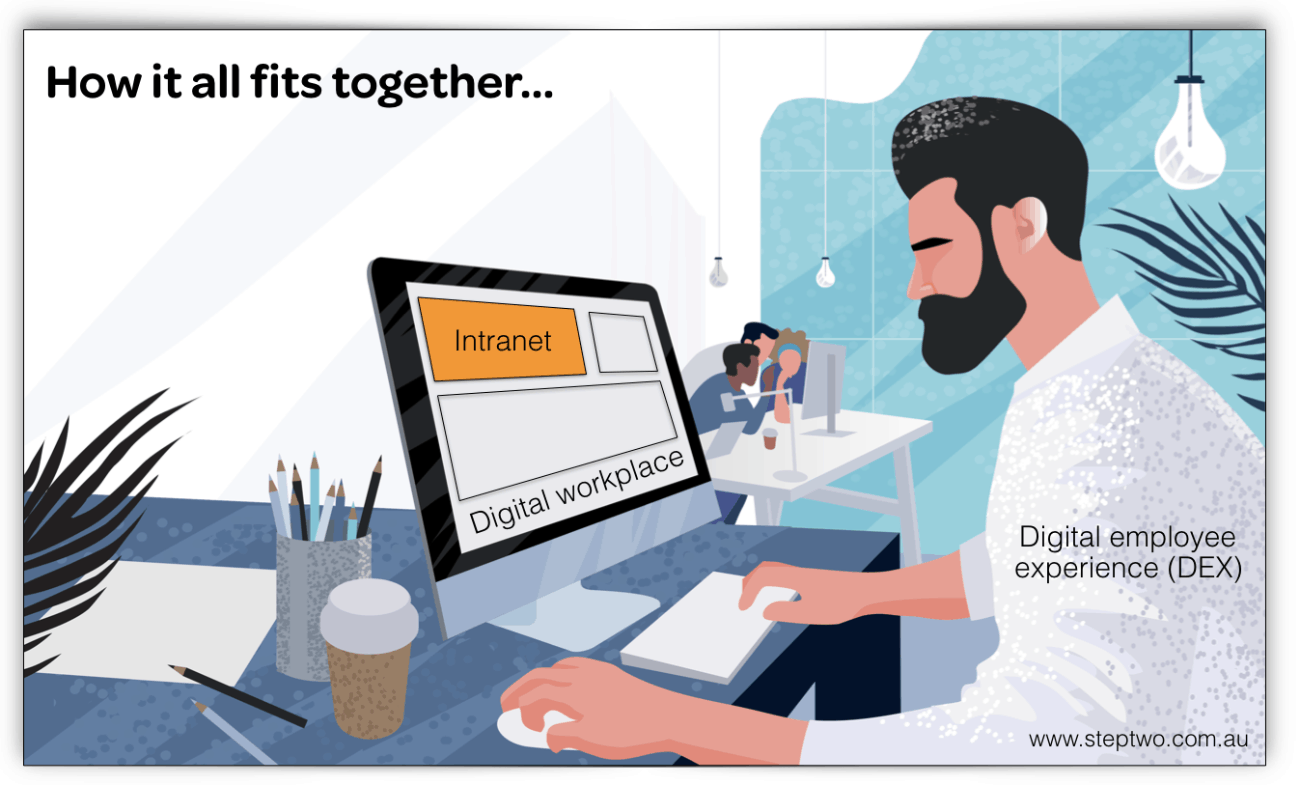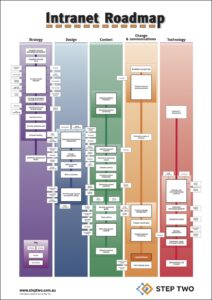
Filed under: Digital employee experience, Digital workplace, Intranets
The concept of an “intranet” has been around for more than 20 years, with varying levels of sophistication. The term “digital workplace” was coined close on ten years ago, although it has only gained traction in recent years. The new kid on the block is “digital employee experience”, providing a holistic and strategic view.
These terms are all now in common use, although definitions vary. There also a lot of confusion: is the latest intranet now a digital workplace? Or is Office 365 the new digital workplace? Can we “deliver” a new digital employee experience?
While Step Two may be leading the charge when it comes to DEX, our work and thinking is always anchored in the real world. We therefore see the three concepts fitting together as shown in this diagram:

Let’s dig into this diagram further.
Modern intranets
Intranets have always been homes for content needed by staff, and channels for internal communication. This hasn’t changed, and intranets continue to play an important role in today’s work environment.
More than just a dumping ground for stuff, we see the role of modern intranets as this:
These key services continue to be content, communication and culture, but now also include a stronger connection to business systems and collaboration tools. (See the five purposes of intranets whitepaper for a useful model.)
Modern intranets also provide an “enterprise front door” to the wider set of digital tools and platforms. This includes surfacing activity in collaboration spaces, and integrating business systems to powerful features such as a “universal inbox”.
Digital workplaces
An intranet is just one of many tools that make up the wider digital workplace. This can be defined very broadly:
That in itself doesn’t say much, as every organisation has had a digital workplace since the introduction of the first digital tools, such as email and Word. It’s more useful to consider what is the digital workplace that we want to have:
What’s important are the attributes of the digital workplace: holistic, coherent, usable and productive. These don’t happen by chance, and there’s a lot of work needed to deliver simplicity, even as the number of digital tools continue to increase.
Digital employee experience
If the digital workplace is “what’s behind the glass”, then digital employee experience can be considered the perspective from “in front of the glass”.
This is the holistic view of how it all comes together for the employee:
It’s not just about the digital tools that are provided by the business, it’s also about the interactions between staff, such as when collaborating.
Using all three definitions
This is not about newer definitions replacing older ones, or competing with each other. All three of the concepts work together within an organisation, and work needs to be done on all three.
Almost certainly you need a better intranet, and over time intranets need to be managed as products, not just as a series of projects.
With the introduction of new tools such as Office 365, Workplace by Facebook, ServiceNow and a host of others, digital workplaces are getting more complex, not less. While this is providing hugely better tools for employees, the complexity can have a crippling impact. Ongoing work needs to be done to align the various elements of the digital workplace, integrating them where needed.
Over all of this, digital employee experience is a concept that can be used to engage senior leaders, recognising that great CX demands great DEX. As a holistic concept, it can provide a future vision and a strategic approach to governance and planning.
At all times, care must be taken not to muddle these concepts. Even though a vendor calls their product a “digital workplace solution”, it may still be best considered an intranet offering. Similarly, a “digital workplace project” must be more than just rolling out a single platform.
Words make a difference, so go forth and use all three: intranets, digital workplace and digital employee experience!





